Beginner’s Guide to Running Facebook Ads That Convert
Getting traffic is easy. Improving your conversions, however – not so easy!
If you’re looking for the best platform to reach your customers, then you should consider Facebook. It’s a huge, ready-made market, with an estimated 1.39 billion active monthly users, according to B2C.
Driving customers – not just visitors – to your landing page is the best way to make sales. A great way to start is with a conversion-based Facebook ad campaign.
With Facebook’s advertising platform, you’ve got access to an audience that shows actual interest in your offer. You can bring them to your site by crafting irresistible ads.
Ultimately, your Facebook ad campaign will only be effective if your landing page is optimized for the user. Otherwise, you’ll most likely struggle to generate leads with your Facebook ads.
When it comes to raising your conversion rate, you’ve got to thoroughly research your audience. No matter how much you have to invest in your ad campaign, start by making sure that you’re targeting your ideal customers.
Download this step by step worksheet to create a Facebook ad that converts.
Without further ado, let me show you how to run a conversion-based Facebook ad campaign that’ll grow your revenue:
Strategy #1: Interest-Based Targeting
Facebook ad targeting is unrivaled in its versatility. You can target your ads based on user location, age, gender, interest, relationship status, education and more.
For example, Adidas launched a soccer-related (football, to my non-American readers!) campaign, during the 2010 World Cup in South Africa. They used Facebook ads to target users, based on their interest in the sport.

During the campaign, their Facebook page reached over 1 million fans and brand awareness grew between 8% and 21% in different countries. You’ve got a lot of potential when running a Facebook ad – the market is huge.

So, let’s say that your organization recently introduced a new coffee brand. You could target Starbucks fans with your ads and maybe entice them to give your product a try:

When you target users based on interest, you’ll notice an increase in the number of email subscribers, Facebook fans, brand advocates and buyers. Overall, you’ll convert more users into customers.
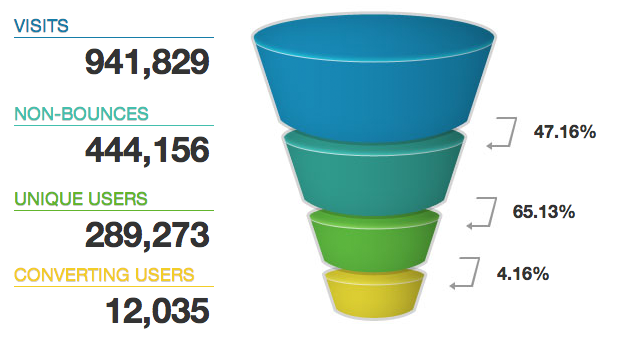
It makes logical sense. If someone isn’t a college graduate, that person won’t likely be interested in taking a grad-school level online course.
In the same vein, if I’ve expressed an interest in table tennis and I see an ad promoting a course promising to make me a better table tennis player, I’m much more likely to click, than if the ad was pitching a course about basketball herunterladen.
A non-profit organization can easily target users based on interest:

Once you define your ad objective, the next step is to select an audience based on one or more interests. These people are usually pre-qualified leads, because they’re already interested in your topic.
Interest-based targeting is especially effective in increasing a Facebook fan base. Here’s an example: the White House Office of National Drug Control Policy created the “Above the Influence” campaign, in order to educate teens on the dangers of substance abuse.

They used Facebook ads to target users based on interests and age. Here are the results they generated:

Remember to set up a lead nurturing system, if you want to maximize your leads, because the vast majority of them aren’t ready to buy your product, yet. You’ll have to educate and persuade them first – and, to do that, you need a system in place to communicate with them regularly.
Strategy #2: Craft a Compelling Lead Magnet
A lead magnet is basically an ethical bribe. It’s what you offer to your leads to persuade them to give you their email address and other contact information.
You can choose from lots of options, when you’re deciding what to give away. For example, Ryan Deiss, founder of Digital Marketer, gave away the social media swipe file below. Within 45 days, he had collected over 28,500 leads.

Bidsketch, a SaaS proposal building application, uses a unique style to ask for your email address before you start the free trial:

If you operate an online store, you could give away discount codes or offer free shipping to your customers. Other lead magnets that have been proven to work include:
- Ebooks and articles
- Video training
- Email courses
- Free tools
- Checklists and templates
Strategy #3: Build High-Converting Landing Pages for Facebook Leads
The moment that you create a landing page, your mindset will shift towards conversion rate – which is where it needs to be. After all, that’s all that matters, once you start attracting Facebook clicks and visitors to your page.
Your landing page should have elements – such as the headline, subtitle and call to action (CTA) – that can be tested and improved.

Changing your CTA button color or position can have a significant impact on your conversion rate. But, it’s just the beginning for building a high-converting landing page. Your page itself needs to be focused on conversions, with persuasive copy that’s relevant to the readers.
According to Instapage, over 1,000 landing pages are designed with their software on a daily basis and this number keeps growing. This illustrates that marketers are embracing landing pages and understand their importance.
The bottom line is this: Whether you’re doing search engine optimization or running a PPC ad with Facebook or Google AdWords, you need a high-converting landing page funny sayings.
You can’t possibly expect people to convert, if you’ve got nothing useful to share with them.
Jayson DeMers said that if you create landing pages properly, you may even enjoy increased SEO benefits, even though your main source of targeted traffic is Facebook.
Hiten Shah, co-founder of KISSmetrics, discussed in his newsletter, a few months ago, that more marketers are creating landing pages for reasons other than new product features or releases.
A recent study by MarketingSherpa agrees with Hiten’s assertion – 67% of marketers are creating unique landing pages for various marketing campaigns or brands.

When a new product is added, these smart marketers also create a new landing page, in order to target a different audience and its specific needs.
When it comes to design, there’s no need to reinvent the wheel. In fact, the landing page where you drive your Facebook clicks should look similar to your typical landing page for running a different type of PPC ad. Focus on the anatomy – the elements that make up the page.

When you come to a well-designed page, you’ll notice the headlines, subtitles, bullet points and more. They’re all important elements on any meaningful landing page.
However, the real concepts that produce a high-converting landing page are always evolving.
Your target customers are used to old techniques and advice. They want something simpler, straightforward and interesting. So, how do you ensure that on your landing page?
1). Borrow credibility: The Stanford Web Credibility research project found that credibility is the most important element for any site.
If you don’t have much credibility online, it’ll affect how people perceive your brand, product and advice. If you’re an author, you’ll find it a lot easier to trust Seth Godin’s publishing advice than mine. He’s got more credibility and experience in that field.
On the other hand, when it comes to digital marketing techniques and strategies, such as SEO and building profitable blogs, more people will trust my recommendations, since that’s my speciality.
But, what do you do when you don’t yet have enough credibility to persuade potential customers?
Simply borrow credibility from other trusted sources. Here’s how:
i). Showcase customer badges: This is a relatively new trend in landing page design win 8 herunterladen. To make your landing page trustworthy and professional, leverage other people’s credibility.

An effective way to borrow an expert’s or brand’s credibility is to showcase their badges on your landing page – assuming that you’ve worked with them in the past. A potential customer who’s still skeptical about your brand will be reassured, if they recognize the brands on your page.
This is called the halo effect, which simply tells us that one positive association increases another. You’re in charge of creating the first impression that you make on your prospects.
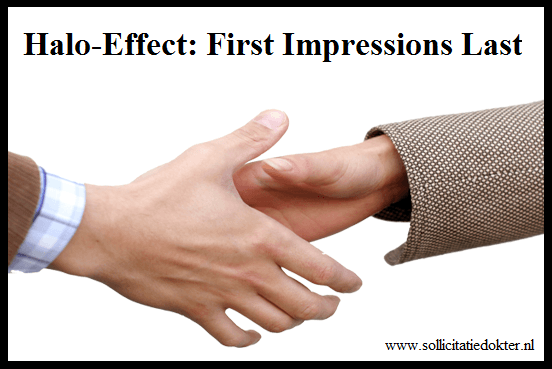
So, if they see a credible brand that you’ve actually worked with (it’s utterly crucial to be honest in this regard), they’ll have a more positive impression of your brand.
An example of a landing page that showcases other brands’ badges is the one from Getresponse, an email marketing solutions company that displays their customers’ logos.

I’m sure that you’ve seen several sites and marketers using customers’ badges on their landing pages. When you see the logos of Coca-Cola, Apple, AirBnB and Unicef on Campaign Monitor’s landing page, aren’t you more willing to do business with them?

ii). Showcase detailed testimonials: You can also build credibility by showcasing the impact of your product or service in people’s lives, through testimonials.
Credibility drives sales and helps you to retain your customers (assuming your services or product are worthy). According to Douglas MacDougall, of MacDougall Biomedical Communications, “without credibility, everything you say to investors, potential partners or even your employees can be questioned.”
The typical Facebook ad landing page contains at least one client testimonial. Here’s an example, from Ontraport. Note the testimonial below the form:
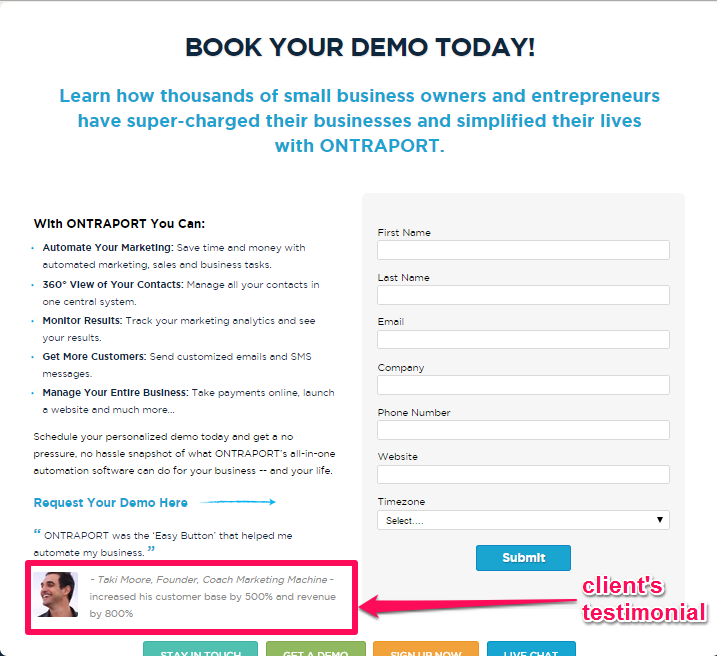
A recent statistic from Spectoos found that 90% of customers’ buying decisions are influenced by customer testimonials and customer reviews. What’s more, over 80% of consumers admit that they’re more likely to buy from a brand that displays reviews and testimonials on its site.
Do you know why Amazon generates more sales than any other brand in the online shopping industry? Take a look at 2013 worldwide figures for online sales:

Granted, Amazon is a very popular and highly credible brand. But, another reason for Amazon’s results is its in-depth, thoughtful and clear customer product reviews, like these:

One word of caution: don’t even think about faking a testimonial on your landing page. Trust me on this: your visitors will know. And, they’ll leave without a second thought. Even worse, such deception can destroy your credibility download the criminal register extract online. In short: be honest.
Showcasing detailed testimonials is a great way to boost your credibility. Xoom, a web payment solution, knows how to strategically place customer testimonials to boost conversions:
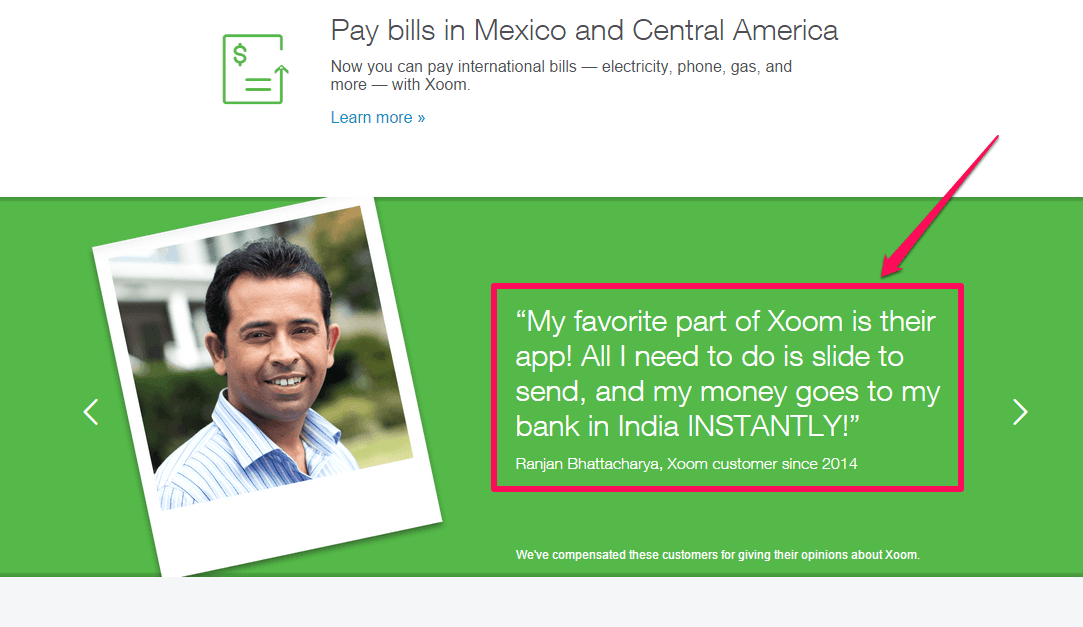
How have organizations and marketers benefited from your offer? It’s very hard to tell the success story with just a logo or photo. In addition to the testimonial copy, make sure that your images display clearly.
According to Kinsta, publishing testimonials on your web page is one of the best ways to build trust. Client testimonials are an integral part of social proof – a phrase that simply means “people are more likely to do what they see others doing.”
If others in your industry got results with your product or service, proof of those results on your page will stoke more interest, helping your ideal clients to subscribe to your list or buy your product. For example, Wiki Jobs added detailed testimonials to their site and boosted their conversion rate by 34%.

2). Give your landing page a SINGLE purpose: What’s your primary motivation for setting up a landing page for your Facebook clicks? If your answer is “to drive traffic, get email sign ups and make sales,” you’re making a big mistake.
There is no way that you can successfully accomplish multiple objectives with a single landing page. Instead, you should create multiple landing pages, each of which appeals to a select group of your ideal customers.

Another benefit to single-objective landing pages is the relative ease of communicating and testing your value proposition. A value proposition is simply a promise of value to be delivered for a given offer, site or brand. MarketingSherpa’s research showed that 64% of marketers find it easier to test value proposition on a landing page.

Take Ramit Sethi’s Six Figure Consulting landing page, for example. It has only one purpose: to promote his course on how to become a consultant earning six figures per year. But, before someone can get Ramit’s insider secrets, they have to subscribe to Ramit’s email list, which is the real purpose of the page.

Ryan Deiss, founder of DigitalMarketer.com, knows how to define the purpose of his landing pages. If you want to become a certified customer value optimization specialist, Ryan doesn’t want you to just subscribe to a list. He wants you to enroll, if you’re ready.

3) raiffeisen elba herunterladen. Optimize your landing pages for conversions: According to David Masters of Tutsplus, “landing pages are the equivalent of your sales team in the online world.” With that in mind, the purpose of your landing page has be well-defined, from the start.
As a Facebook advertiser, you have to remember that generating leads is the ultimate purpose behind running an ad, no matter what type of ad you’re running.
Even if you’re sponsoring a blog post, you still want to convert more visitors into blog readers. So, conversion is the ultimate by-product of any PPC ad.
Continually optimize for conversions. Many people don’t really know what optimization means. But, it’s actually a pretty simple concept. It boils down to two things:
- Do more of what works
- Quit doing what doesn’t work
There are two ways to optimize your landing page in order to improve conversions:

Above all, you should remove every distraction on your landing page. Make it easy for your site visitors to find exactly what they’re looking for. Use explicit cues to guide users to your offer or call-to-action.
Most successful marketers use directional cues on their opt-in boxes. For example, Copyhackers uses a cartoon-like character that points at the opt-in call-to-action button.

Marie Forleo uses a white arrow to direct users to her email subscription box. It helps the visitor avoid getting lost on the page.
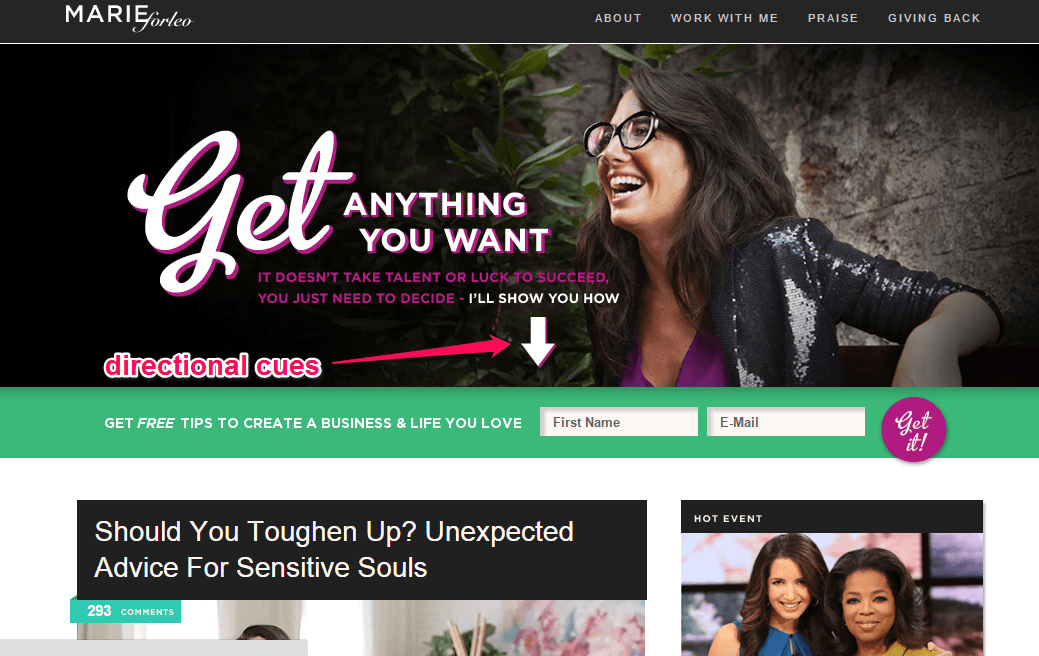
Another way that you can use directional cues is to include a short (one or two sentences) and appealing message, right before your subscription box.
Write the message persuasively. Here’s how Expert Photography crafted directional cues in one sentence:

In the landing page above, you’ll notice that there is a video. Adding a video to your landing page will position you as an expert in your industry. After all, if you can show it, then you’re different from those who can only write about it.
Video is an integral part of visual marketing and the brain responds to it better than straight text. Eyeviewdigital.com saw an 80% increase in its conversion rate, after adding a video to a landing page.
Many people prefer watching videos over reading plain text. What’s more, videos will keep more people on your page for a longer time.

Removing navigation from your page is another way to optimize and achieve a higher conversion rate with your landing page.
For example, Career Point College removed the top navigation on its landing page and modified the form layout. The result was an increase in conversion rate of 336%.
And, SparkPage increased its conversion rate from 9.2% to 17.6% in the month when they ran a test and removed the top navigation.
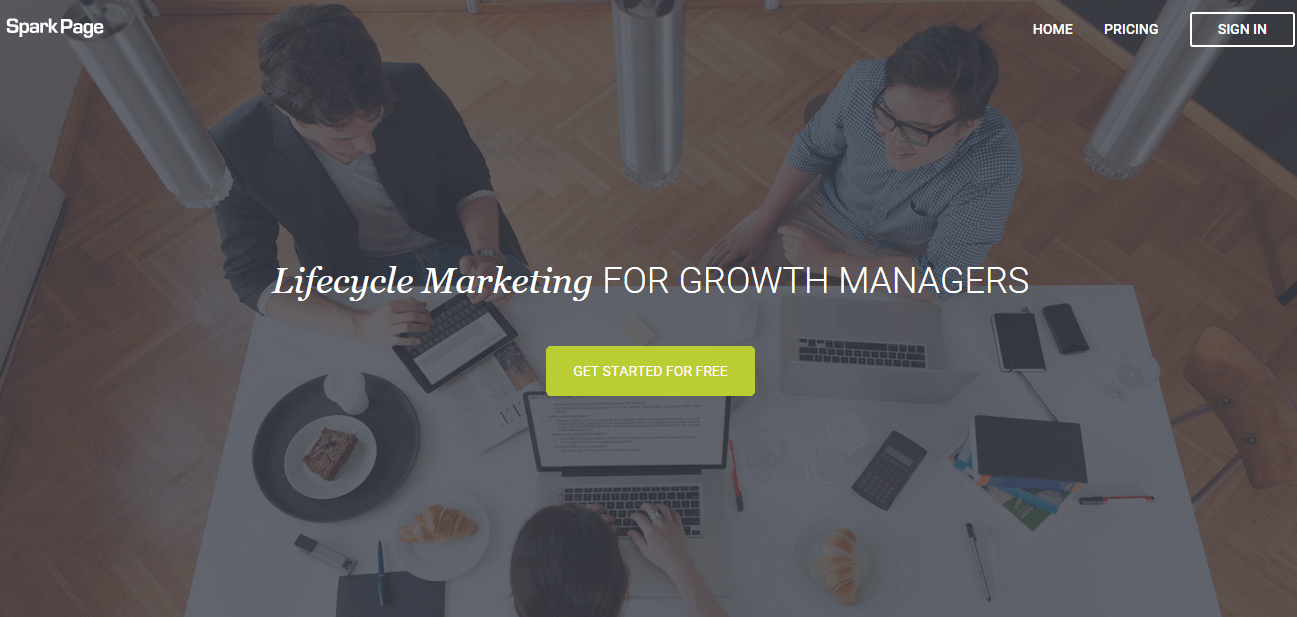
Removing navigations on your landing page will lift your conversions pictures from google photos. A lot of authors, information marketers and public speakers are doing exactly that.
Before we wrap up landing page optimization, we have to address the call-to-action. If you’re using a CTA button on your landing page, the words you use will either persuade people to act or chase them away. Avoid boring copy on your buttons.
If you’re still using the word “submit” on your button, you’re doing yourself a huge disservice. Instead, clearly describe what the users stand to gain by taking the action.
HubSpot recently tested landing page CTA buttons, to compare the effect of buttons that use the word “submit” against buttons that didn’t use the word “submit.”
The “submit” button didn’t perform very well. The button with more descriptive wording got a 17% higher conversion rate.

Bryan Harris, founder of Videofruit.com, removed the top navigation and sidebar on his landing page and crafted clear copy for his button. Here’s his landing page:

To save time and build professional landing pages for your Facebook ads, you’ve got several options. You could use one of the templates from Leadpages, Instapage or Optimizepress. But, if you want to carry out A/B testing, Unbounce may be the best option for you.

Strategy #4: Drive Qualified Traffic to Your Landing Page From Facebook
Facebook PPC advertising is a great source of traffic for your landing page. Smart content marketers leverage the #1 social media platform to generate high-quality traffic and convert those visitors into customers.
If you’ve got the requisite marketing budget for both organic and PPC traffic, you’ll see better results, compared to using one platform alone (such as PPC or organic search).

Glen Allsopp, founder of Viperchill.com, received thousands of qualified clicks, at a cheaper rate, using Facebook ads instead of Google AdWords.
He spent $2 with Facebook to acquire a customer, whereas Google took $40 to get the same client to his site. Of course, there are ways to get a cheaper CPC on Google AdWords, but many marketers and PPC advertisers prefer Facebook.
More importantly, the Facebook team will usually approve your ad within 15 minutes and start sending traffic to your landing page. Google AdWords can take 10 – 15 hours.
In a recent test to determine the effect of PPC on a landing page, compared to free sources of traffic, Melissa Mackey saw a 17% increase in site visits after setting up a PPC campaign. Her sales increased as well.

Of course, you need to know the cost per acquisition (CPA) when running a Facebook ad – that’s how much a particular click will cost you.
This means that if Facebook deducts $1.43 from your account for every click, your cost per acquisition (CPA) is $1.43. Assuming that you’ve got the same budget for both organic search and PPC, this research shows that PPC will yield the better ROI for you elicenser herunterladen.
If you’ve got a high-converting landing page, a compelling offer and clickable Facebook ad copy, PPC traffic will convert 3.5 times better than non-PPC traffic.
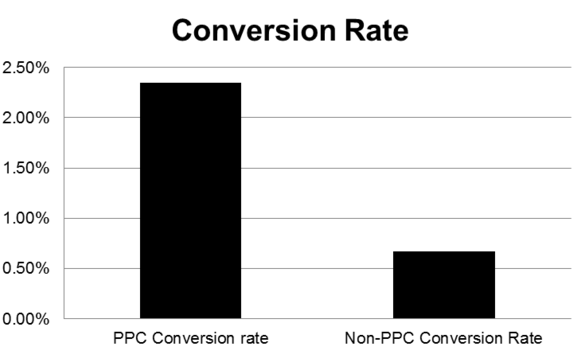
1). Set up conversion tracking: Since conversion is the ultimate goal, you’ve got to set up conversion tracking properly.

From your Facebook ads set up environment, you can optimize and track conversions, by placing a conversion pixel on your site and then adding it to a Facebook ad. This is a simple and effective way to know exactly which ads are converting the most.
If you use WordPress, you can download and install the Facebook Tracking Pixel plugin, which adds the Facebook conversion pixel code to your WordPress landing pages.
You can also use optimized CPM to target your ads to the right audience, so that you don’t waste your clicks or your money. Optimized CPM (oCPM) is an integral aspect of conversion tracking best practices:
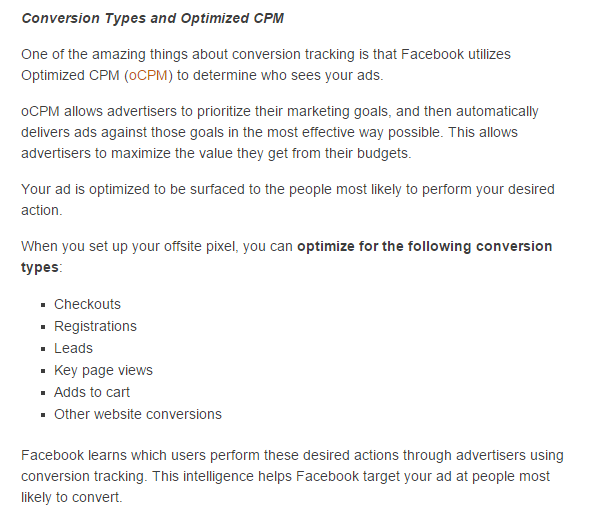
Here are the simple steps to set up a Facebook conversion pixel:
Step #1: On your Facebook Ads manager, click the Conversion Tracking tab on the left side.

Step #2: From the drop-down menu, give your conversion pixel a name that’s easy to remember. Then, select a category that best describes the type of conversion that you want to see.

Step #3: Click Create Pixel.
Step #4: Copy the code that appears.

Then paste it within the opening and closing <head> tags of your web page:

You could also use the Power Editor to create a conversion pixel that will help you track conversions on your Facebook ad clicks. Follow these steps:
Step #1: Go to Power Editor.
Step #2: Click the Manage Ads drop-down, in the top-left corner and select Conversion Tracking.

Step #3: Click Create Pixel.
Step #4: Select a category from the drop-down menu and give your conversion pixel a name.
Step #5: Click Create Pixel.
Step #6: Copy the code that appears and add it to your web page, as above.
2). Craft a powerful Facebook ad design: Is it the job of the landing page or the Facebook ad to convert clicks into leads? Well, I think they both play a vital role.
When you’re creating an ad design, consider the experience of the user. Here’s a recent comment from Filip Galetic:

What the person making the comment needs to understand is that none of these elements (landing page, cost per click, amount of traffic, conversion and ad) will function independent of the other. They should all work together to generate the best results.
Throwing money at Facebook to drive visitors to your landing page will only work if you’re smart herunterladen. I know a lot of people who have lost money running Facebook ads. Yet others, such as Ryan Deiss and Jon Loomer, are seeing great results from Facebook advertising.
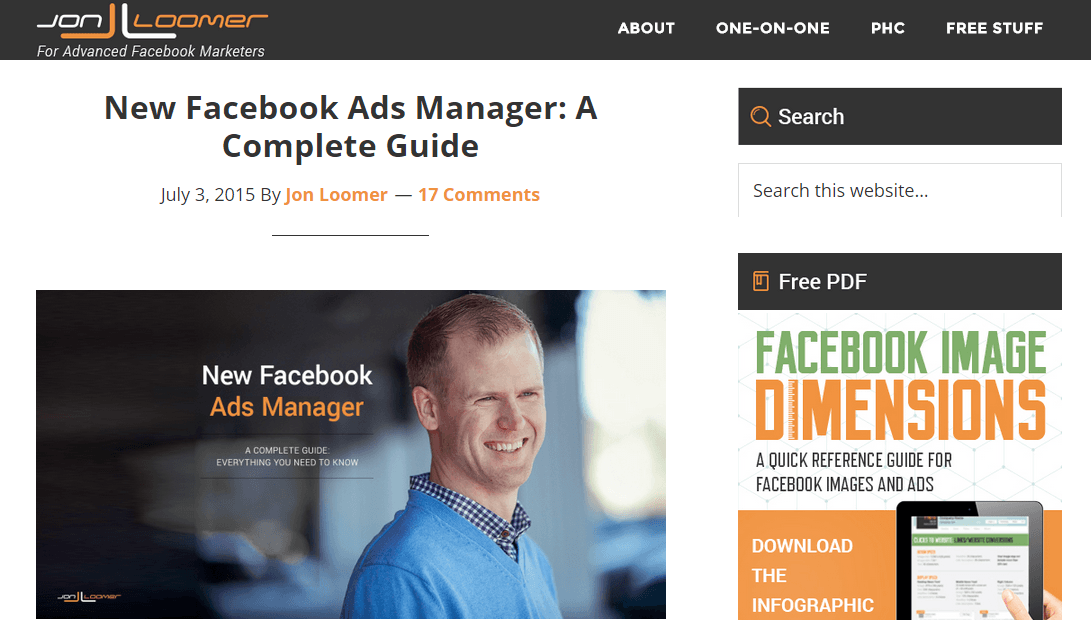
When writing your Facebook ads, be clear and concise about your offer. You won’t come off as being too promotional, if your ad itself delivers value. Save fancy introductions for later.
This means that if your brand is not yet known by your target audience, you should not use it in your ad copy. Amazon, Ebay, Seth Godin and Guy Kawasaki can use their brand names, because you and I (their target audience) are familiar with those names.

When writing your Facebook ads, make sure that you include the four elements below:
i). Visual: Visual information is valuable in the Facebook algorithm. In the ever-evolving News Feed, visual information will engage your target audience more than straight text.
But, you also have to know the difference in picture quality and composition.

Since the brain processes visuals 60,000 times faster than plain text, include clear, professional and relevant visuals (e.g., image of objects, humans) to entice your audience.

Here are great examples of clear & relevant visuals used in different Facebook ads:

Since your Facebook ad is going to appear on the right side of a user’s homepage, make sure that your images and photos are attractive, easily understood at first sight and aligned with the ad copy. See examples below:

ii). Relevant ad: Your ad headline, visuals, ad copy and call-to-action must all be relevant. Depending on your settings, you’ll be spending money when someone views or clicks your ad. Make each view or click count.
An example of a relevant Facebook ad is below:

Facebook recently launched a feature that’s similar to Ad Rank in Google AdWords. This Facebook feature will give you a relevance score, after evaluating your ad.


Work to increase your Facebook ad relevance score. Make your headline, ad text, ad image, copy and destination page relevant and appealing to your audience.
If you can do that, Facebook will give your ads higher priority, which ultimately means more highly-targeted users being sent to your landing page.
iii). Value proposition: Make a promise of value in your ad. The value proposition will set your product or offer apart from the competition c# dateien herunterladen. This chart explains it better:

If you claim that your latest book is useful, not many people will simply give you the benefit of the doubt on that point. But, if you give away a few chapters for free, it’s easier for people to draw their own conclusions.
In the same vein, offering a 30% discount on your meal plans, if you’re a fitness trainer, will quickly boost your credibility and change how people perceive your ad. Here’s a powerful value proposition from a recent AirBnB Facebook ad.
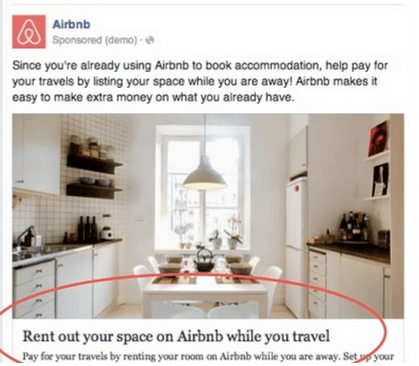
iv). A clear call-to-action: There is no shortcut to getting people to act – you have to include a call-to-action.
Unfortunately, most marketers aren’t doing it. According to SmallBizTrends, 70% of small business B2B sites don’t have a CTA.

You need a call-to-action button, on both your ad and your landing page. Without it, your best headlines, professionally-looking and relevant images and compelling ad copy will be wasted.
Yet, many Facebook advertisers totally ignore that ad CTA.
Here’s a Facebook video ad with a strong call-to-action:

Whether you’re running a video ad or photo ad, what matters is that you persuade users to click and visit your landing page. From there, you can follow up with the leads who indicated interest in your ad and persuade them to buy.
Strategy #5: Low-Friction Conversions
Improving your conversions is the ultimate goal of every PPC ad campaign. It’s little wonder that 85% of search marketing experts will pay more attention to conversion rate optimization (CRO) this year.
Many people are using Facebook advertising the wrong way. If you haven’t created a way to capture and nurture your audience, you’ll waste a lot of money.
Low-friction conversions are the best approach, when running a Facebook ad campaign. Smart Facebook PPC advertisers don’t come to Facebook to make sales. Instead, they offer a high-quality lead magnet to their users, in order to get them to subscribe to an email list.

From there, it’s a lot easier to offer great value, eliminate push back and give users exactly what they’re asking for: education.
Of course, if you’re an ecommerce store owner, you could simply send people to your product pages and convert them to sales there.
But, for information marketers, business consultants, freelancers and others who aren’t selling a physical product, you’ve got to get people onto your email list, first herunterladen. That’s why autoresponders exist.

Your landing page visitor didn’t come to buy a product, but to learn about you. What matters is the environment that you’ll create for them. Will that environment inspire them to buy from you, or repel them from your offer, due to excessive pressure or greed?
Your Facebook ads will yield the best results, if you set up a conversion funnel, then create useful content that your leads will benefit from. Then, nurture your leads on a regular basis, before asking for the sale.

Remember, you need to continually test your performance to determine what’s working for you and what’s not. The Facebook ad terrain is always changing and you’ve got to adapt to it.
Here’s an excerpt from KISSmetrics on testing and tracking your metrics:

Conclusion
If you create Facebook ads, you need to set up an ongoing system to review and analyze your ads. Then, you can effectively make tweaks to your campaign. This is how you pin down what works best for you.
But, if you abandon your ad and lose focus, you may end up driving the wrong people to your blog and waste your money in the process.
So, what’s the most important factor of every Facebook ad?
As I said earlier, the landing page offer, the landing page itself, the ad copy, the image, the call-to-action – they’re all vital. They all work together to help you reach your target audience.
What other strategies do you use, when running a Facebook ad campaign to improve your conversions?



